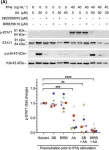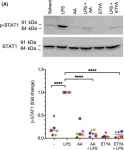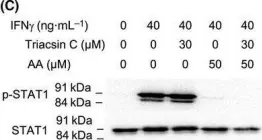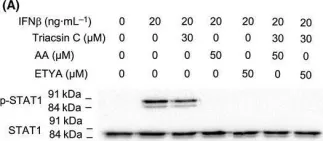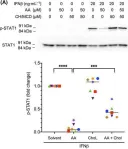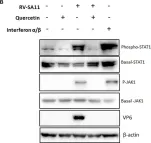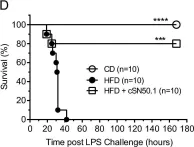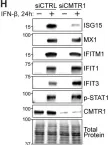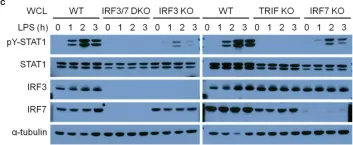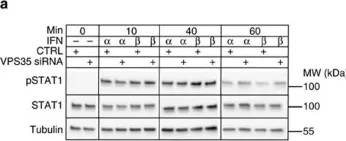High levels of the polyunsaturated fatty acid arachidonic acid (AA) within the ovarian carcinoma (OC) microenvironment correlate with reduced relapse-free survival. Furthermore, OC progression is tied to compromised immunosurveillance, partially attributed to the impairment of natural killer (NK) cells. However, potential connections between AA and NK cell dysfunction in OC have not been studied.
We employed a combination of phosphoproteomics, transcriptional profiling and biological assays to investigate AA's impact on NK cell functions.
AA (i) disrupts interleukin-2/15-mediated expression of pro-inflammatory genes by inhibiting STAT1-dependent signaling, (ii) hampers signaling by cytotoxicity receptors through disruption of their surface expression, (iii) diminishes phosphorylation of NKG2D-induced protein kinases, including ERK1/2, LYN, MSK1/2 and STAT1, and (iv) alters reactive oxygen species production by transcriptionally upregulating detoxification. These modifications lead to a cessation of NK cell proliferation and a reduction in cytotoxicity.
Our findings highlight significant AA-induced alterations in the signaling network that regulates NK cell activity. As low expression of several NK cell receptors correlates with shorter OC patient survival, these findings suggest a functional linkage between AA, NK cell dysfunction and OC progression.
© 2024. The Author(s).
Product Citations: 36
In Cell Communication and Signaling : CCS on 19 November 2024 by Hammoud, M. K., Meena, C., et al.
-
WB
-
Homo sapiens (Human)
-
Endocrinology and Physiology
Preprint on BioRxiv : the Preprint Server for Biology on 16 December 2023 by Li, C., Hamon, Y., et al.
Activation of JAK/STAT signaling by IFN-γ requires partitioning of IFN-γR into specific lipid nanodomains at the plasma membrane. Using IFN-γR as a proxy, we investigated the role of actin dynamics in the formation and organization of lipid nanodomains, a process that remains poorly understood. We identified formin Dia2/DIAPH3 as a specific and RhoA -dependent regulator of IFN-γ-induced JAK/STAT signaling. Based on lipidomics and specific probes enabling membrane lipid imaging by super resolution microscopy, we demonstrate that Dia2 is required for proper assembly of sphingomyelin and cholesterol lipid complexes. Finally, we show that the disorganization of lipid nanodomains induced by Dia2 depletion results in drastic changes in nano-partitioning and activity of other membrane proteins, such as Thy1 and PD-L1. Our data establish, therefore, the central role of the RhoA-Dia2 axis in the regulation of IFN-γ induced JAK/STAT signaling, and more broadly, in the nanoscale organization of the plasma membrane.
Tumor heterogeneity and tumor-microglia interactions in primary and recurrent IDH1-mutant gliomas.
In Cell Reports Medicine on 21 November 2023 by Blanco-Carmona, E., Narayanan, A., et al.
The isocitrate dehydrogenase (IDH) gene is recurrently mutated in adult diffuse gliomas. IDH-mutant gliomas are categorized into oligodendrogliomas and astrocytomas, each with unique pathological features. Here, we use single-nucleus RNA and ATAC sequencing to compare the molecular heterogeneity of these glioma subtypes. In addition to astrocyte-like, oligodendrocyte progenitor-like, and cycling tumor subpopulations, a tumor population enriched for ribosomal genes and translation elongation factors is primarily present in oligodendrogliomas. Longitudinal analysis of astrocytomas indicates that the proportion of tumor subpopulations remains stable in recurrent tumors. Analysis of tumor-associated microglia/macrophages (TAMs) reveals significant differences between oligodendrogliomas, with astrocytomas harboring inflammatory TAMs expressing phosphorylated STAT1, as confirmed by immunohistochemistry. Furthermore, inferred receptor-ligand interactions between tumor subpopulations and TAMs may contribute to TAM state diversity. Overall, our study sheds light on distinct tumor populations, TAM heterogeneity, TAM-tumor interactions in IDH-mutant glioma subtypes, and the relative stability of tumor subpopulations in recurrent astrocytomas.
Copyright © 2023 The Author(s). Published by Elsevier Inc. All rights reserved.
-
Homo sapiens (Human)
-
Cancer Research
-
Neuroscience
In Molecular Oncology on 1 September 2022 by Hammoud, M. K., Dietze, R., et al.
Survival of ovarian carcinoma is associated with the abundance of immunosuppressed CD163high CD206high tumor-associated macrophages (TAMs) and high levels of arachidonic acid (AA) in the tumor microenvironment. Here, we show that both associations are functionally linked. Transcriptional profiling revealed that high CD163 and CD206/MRC1 expression in TAMs is strongly associated with an inhibition of cytokine-triggered signaling, mirrored by an impaired transcriptional response to interferons and IL-6 in monocyte-derived macrophages by AA. This inhibition of pro-inflammatory signaling is caused by dysfunctions of the cognate receptors, indicated by the inhibition of JAK1, JAK2, STAT1, and STAT3 phosphorylation, and by the displacement of the interferon receptor IFNAR1, STAT1 and other immune-regulatory proteins from lipid rafts. AA exposure led to a dramatic accumulation of free AA in lipid rafts, which appears to be mechanistically crucial, as the inhibition of its incorporation into phospholipids did not affect the AA-mediated interference with STAT1 phosphorylation. Inhibition of interferon-triggered STAT1 phosphorylation by AA was reversed by water-soluble cholesterol, known to prevent the perturbation of lipid raft structure by AA. These findings suggest that the pharmacologic restoration of lipid raft functions in TAMs may contribute to the development new therapeutic approaches.
© 2022 The Authors. Molecular Oncology published by John Wiley & Sons Ltd on behalf of Federation of European Biochemical Societies.
-
WB
-
Homo sapiens (Human)
-
Cancer Research
In Frontiers in Microbiology on 20 August 2022 by Banerjee, S., Sarkar, R., et al.
Rotavirus (RV) is the leading cause of acute gastroenteritis and watery diarrhea in children under 5 years accounting for high morbidity and mortality in countries with poor socioeconomic status. Although vaccination against RV has been implemented in more than 100 countries, the efficacy of vaccine has been challenged in low-income settings. The lack of any FDA-approved drug against RV is an additional concern regarding the treatment associated with rotavirus-induced infantile death. With the purpose for the discovery of anti-RV therapeutics, we assessed anti-rotaviral potential of quercetin, a well-characterized antioxidant flavonoid. In vitro study revealed that quercetin treatment resulted in diminished production of RV-SA11 (simian strain) viral particles in a concentration-dependent manner as estimated by the plaque assay. Consistent with this result, Western blot analysis also revealed reduced synthesis of viral protein in quercetin-treated RV-SA11-infected MA104 cells compared to vehicle (DMSO) treated controls. Not surprisingly, infection of other RV strains A5-13 (bovine strain) and Wa (Human strain) was also found to be abridged in the presence of quercetin compared to DMSO. The IC50 of quercetin against three RV strains ranges between 2.79 and 4.36 Mm, and S.I. index is greater than 45. Concurrent to the in vitro results, in vivo study in mice model also demonstrated reduced expression of viral proteins and viral titer in the small intestine of quercetin-treated infected mice compared to vehicle-treated infected mice. Furthermore, the result suggested anti-rotaviral activity of quercetin to be interferon-independent. Mechanistic study revealed that the antiviral action of quercetin is co-related with the inhibition of RV-induced early activation of NF-κB pathway. Overall, this study delineates the strong anti-RV potential of quercetin and also proposes it as future therapeutics against rotaviral diarrhea.
Copyright © 2022 Banerjee, Sarkar, Mukherjee, Miyoshi, Kitahara, Halder, Koley and Chawla-Sarkar.
-
WB
-
Immunology and Microbiology
In Mol Oncol on 1 September 2022 by Hammoud, M. K., Dietze, R., et al.
Fig.4.B

-
WB
-
Collected and cropped from Mol Oncol by CiteAb, provided under a CC-BY license
Image 1 of 12
In Mol Oncol on 1 September 2022 by Hammoud, M. K., Dietze, R., et al.
Fig.6.A

-
WB
-
Collected and cropped from Mol Oncol by CiteAb, provided under a CC-BY license
Image 1 of 12
In Mol Oncol on 1 September 2022 by Hammoud, M. K., Dietze, R., et al.
Fig.7.A

-
WB
-
Collected and cropped from Mol Oncol by CiteAb, provided under a CC-BY license
Image 1 of 12
In Mol Oncol on 1 September 2022 by Hammoud, M. K., Dietze, R., et al.
Fig.9.C

-
WB
-
Collected and cropped from Mol Oncol by CiteAb, provided under a CC-BY license
Image 1 of 12
In Mol Oncol on 1 September 2022 by Hammoud, M. K., Dietze, R., et al.
Fig.9.A

-
WB
-
Collected and cropped from Mol Oncol by CiteAb, provided under a CC-BY license
Image 1 of 12
In Mol Oncol on 1 September 2022 by Hammoud, M. K., Dietze, R., et al.
Fig.10.A

-
WB
-
Collected and cropped from Mol Oncol by CiteAb, provided under a CC-BY license
Image 1 of 12
In Front Microbiol on 20 August 2022 by Banerjee, S., Sarkar, R., et al.
Fig.3.B

-
WB
-
Collected and cropped from Front Microbiol by CiteAb, provided under a CC-BY license
Image 1 of 12
In Sci Rep on 7 June 2021 by Liu, Y., Zienkiewicz, J., et al.
Fig.1.D

-
WB
-
Homo sapiens (Human)
Collected and cropped from Sci Rep by CiteAb, provided under a CC-BY license
Image 1 of 12
In mSphere on 13 May 2020 by Williams, G. D., Gokhale, N. S., et al.
Fig.1.H

-
WB
-
Collected and cropped from mSphere by CiteAb, provided under a CC-BY license
Image 1 of 12
In mSphere on 13 May 2020 by Williams, G. D., Gokhale, N. S., et al.
Fig.1.E

-
WB
-
Collected and cropped from mSphere by CiteAb, provided under a CC-BY license
Image 1 of 12
In Front Immunol on 7 May 2020 by Sin, W. X., Yeong, J. P., et al.
Fig.7.C

-
WB
-
Mus musculus (House mouse)
Collected and cropped from Front Immunol by CiteAb, provided under a CC-BY license
Image 1 of 12
In Nat Commun on 5 December 2016 by Chmiest, D., Sharma, N., et al.
Fig.7.A

-
WB
-
Collected and cropped from Nat Commun by CiteAb, provided under a CC-BY license
Image 1 of 12

